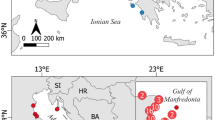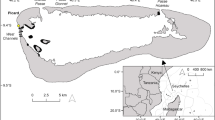Abstract
In response to a call from the US National Research Council for research programs to combine their data to improve sea turtle population assessments, we analyzed somatic growth data for Northwest Atlantic (NWA) loggerhead sea turtles (Caretta caretta) from 10 research programs. We assessed growth dynamics over wide ranges of geography (9–33°N latitude), time (1978–2012), and body size (35.4–103.3 cm carapace length). Generalized additive models revealed significant spatial and temporal variation in growth rates and a significant decline in growth rates with increasing body size. Growth was more rapid in waters south of the USA (<24°N) than in USA waters. Growth dynamics in southern waters in the NWA need more study because sample size was small. Within USA waters, the significant spatial effect in growth rates of immature loggerheads did not exhibit a consistent latitudinal trend. Growth rates declined significantly from 1997 through 2007 and then leveled off or increased. During this same interval, annual nest counts in Florida declined by 43 % (Witherington et al. in Ecol Appl 19:30–54, 2009) before rebounding. Whether these simultaneous declines reflect responses in productivity to a common environmental change should be explored to determine whether somatic growth rates can help interpret population trends based on annual counts of nests or nesting females. Because of the significant spatial and temporal variation in growth rates, population models of NWA loggerheads should avoid employing growth data from restricted spatial or temporal coverage to calculate demographic metrics such as age at sexual maturity.




Similar content being viewed by others
References
Arendt MD, Segars AL, Byrd JI, Boynton J, Whitaker JD, Parker L, Owens DW, Blanvillain G, Quattro JM, Roberts MA (2012) Seasonal distribution patterns of juvenile loggerhead sea turtles (Caretta caretta) following capture from a shipping channel in the Northwest Atlantic Ocean. Mar Biol 159:127–139
Balazs GH, Chaloupka M (2004) Spatial and temporal variability in somatic growth of green sea turtles (Chelonia mydas) resident in the Hawaiian Archipelago. Mar Biol 145:1043–1059
Bjorndal KA, Bolten AB (2010) Hawksbill sea turtles in seagrass pastures: success in a peripheral habitat. Mar Biol 157:135–145
Bjorndal KA, Meylan AB, Turner BJ (1983) Sea turtles nesting at Melbourne Beach, Florida, 1. Size, growth and reproductive biology. Biol Conserv 26:65–77
Bjorndal KA, Bolten AB, Chaloupka MY (2000) Green turtle somatic growth model: evidence for density dependence. Ecol Appl 10:269–282
Bjorndal KA, Bolten AB, Dellinger T, Delgado C, Martins HR (2003) Compensatory growth in oceanic loggerhead sea turtles: response to a stochastic environment. Ecology 84:1237–1249
Bjorndal KA, Bowen BW, Chaloupka M, Crowder LB, Heppell SS, Jones CM, Lutcavage ME, Policansky D, Solow AR, Witherington BE (2011) From crisis to opportunity: Better science needed for restoration in the Gulf of Mexico. Science 331:537–538
Bjorndal KA, Parsons J, Mustin W, Bolten AB (2013) Threshold to maturity in a long-lived reptile: interactions of age, size and growth. Mar Biol 160:607–616
Bolten AB (1999) Techniques for measuring sea turtles. In: Eckert KL, Bjorndal KA, Abreu Grobois FA, Donnelly M (eds) Management and research techniques for the conservation of sea turtles. IUCN, Gland, pp 110–114
Bolten AB (2003) Active swimmers—passive drifters: the oceanic juvenile stage of loggerheads in the Atlantic system. In: Bolten AB, Witherington BE (eds) Loggerhead sea turtles. Smithsonian Institution Press, Washington, pp 63–78
Bowen BW, Bass AL, Chow SM, Bostrom M, Bjorndal KA, Bolten AB, Okuyama T, Bolker BM, Epperly S, LaCasella E, Shaver D, Dodd M, Hopkins-Murphy SR, Musick JA, Swingle M, Rankin-Baransky K, Teas W, Witzell WN, Dutton PH (2004) Natal homing in juvenile loggerhead turtles (Caretta caretta). Mol Ecol 13:3797–3808
Braun-McNeill J, Epperly SP, Avens L, Snover ML, Taylor JC (2008) Growth rates of loggerhead sea turtles (Caretta caretta) from the western North Atlantic. Herp Conserv Biol 3:273–281
Chaloupka MY, Musick JA (1997) Age, growth, and population dynamics. In: Lutz PL, Musick JA (eds) The biology of sea turtles. CRC Press, Boca Raton, pp 233–276
Chaloupka M, Limpus C, Miller J (2004) Green turtle somatic growth dynamics in a spatially disjunct Great Barrier Reef metapopulation. Coral Reefs 23:325–335
Chaloupka M, Kamezaki N, Limpus C (2008) Is climate change affecting the population dynamics of the endangered Pacific loggerhead sea turtle? J Exp Mar Biol Ecol 356:136–143
Engstrom TN, Meylan PA, Meylan AB (2002) Origin of juvenile loggerhead turtles (Caretta caretta) in a tropical developmental habitat in Caribbean Panama. Anim Conserv 5:125–133
Florida Fish and Wildlife Conservation Commission (2012) Trends in nesting by Florida loggerheads. http://www.myfwc.com/research/wildlife/sea-turtles/nesting/loggerhead-trends/. Accessed 29 Dec 2012
Hawkes LA, Broderick AC, Coyne MS, Godfrey MH, Godley BJ (2007) Only some like it hot—quantifying the environmental niche of the loggerhead sea turtle. Divers Distrib 13:447–457
Heppell SS, Crowder LB, Crouse DT, Epperly SP, Frazer NB (2003) Population models for Atlantic loggerheads: past, present, and future. In: Bolten AB, Witherington BE (eds) Loggerhead sea turtles. Smithsonian Institution Press, Washington, pp 255–273
Hopkins-Murphy SR, Owens DW, Murphy TM (2003) Ecology of immature loggerheads on foraging grounds and adults in internesting habitat in the eastern United States. In: Bolten AB, Witherington BE (eds) Loggerhead sea turtles. Smithsonian Institution Press, Washington, pp 79–92
IUCN (2012) Caretta caretta. The IUCN red list of threatened species. http://www.iucnredlist.org/details/3897/0. Accessed 29 December 2012
Jackson JBC, Kirby MX, Berger WH, Bjorndal KA et al (2001) Historical overfishing and the recent collapse of coastal ecosystems. Science 293:629–638
Kubis S, Chaloupka M, Ehrhart L, Bresette M (2009) Growth rates of juvenile green turtles Chelonia mydas from three ecologically distinct foraging habitats along the east central coast of Florida, USA. Mar Ecol Prog Ser 389:257–269
Madsen T, Shine R (2000) Silver spoons and snake body sizes: prey availability early in life influences long-term growth rates of free-ranging pythons. J Anim Ecol 69:952–958
Mansfield KL, Saba VS, Keinath JA, Musick JA (2009) Satellite tracking reveals a dichotomy in migration strategies among juvenile loggerhead turtles in the Northwest Atlantic. Mar Biol 156:2555–2570
Meylan A (1982) Sea turtle migration—evidence from tag returns. In: Bjorndal KA (ed) Biology and conservation of sea turtles. Smithsonian Institution Press, Washington, pp 91–100
Meylan PA, Meylan AB, Gray JA (2011) The ecology and migrations of sea turtles. 8, Tests of the developmental habitat hypothesis. Bull Am Mus Nat Hist 357:1–70
National Research Council (2010) Assessment of sea-turtle status and trends: integrating demography and abundance. National Academies Press, Washington
Saba VS, Stock CA, Spotila JR, Paladino FV, Tomilla PS (2012) Projected response of an endangered marine turtle population to climate change. Nature Clim Change 2:814–820
Scott R, Marsh R, Hays GC (2012) Life in the really slow lane: loggerhead sea turtles mature late relative to other reptiles. Funct Ecol 26:227–235
TEWG (Turtle Expert Working Group) (2009) An assessment of the loggerhead turtle population in the western northern Atlantic Ocean. NOAA Tech Mem NMFS-SEFSC-575, Miami, FL
Van Houtan KS, Halley JM (2011) Long-term climate forcing in loggerhead sea turtle nesting. PLoS ONE 6:e19043
Witherington B, Kubilis P, Brost B, Meylan A (2009) Decreasing annual nest counts in a globally important loggerhead sea turtle population. Ecol Appl 19:30–54
Acknowledgments
We are very grateful to the many people who assisted with turtle captures and measurements: B. Bolt, A. Brame, B. Brost, R. Burrows, J. Byrd, R. Cancro, E. Chadwick, M. Cherkiss, S. Connett, C. Crady, B. Crouchley, S. Gann, C. Hackett, T. Hirama, R. Lowers, K. Holloway-Adkins, K. Ludwig, K. Minch, H. Nixon, J. Nixon, S. Nixon, L. Ogren, M. Provancha, T. Redlow, E. Reyier, B. Reynolds, A. Sartain, D. Scheidt, J. Schwenter, A. Segars, B. Stephens, and W. Witzell. For logistical support, we thank C. Douglass, J. Douglass, T. Gottshall, K. Nimmo, J. Spade, and T. Ziegler. For data management, we thank P.E. Eliazar. We used the Maptool program (see www.seaturtle.org) to create the map in this paper. Our studies were supported by several funding sources: Disney Worldwide Conservation Fund, Florida Fish and Wildlife Conservation Commission, NASA-John F. Kennedy Space Center, National Marine Fisheries Service, National Park Service, US Geological Survey, and the Wildlife Conservation Society (New York). All turtle captures and handling were conducted with appropriate national and state research permits and approved IACUC protocols, where applicable. Any use of trade, product, or firm names is for descriptive purposes only and does not imply endorsement by the US Government.
Conflict of interest
The authors declare that they have no conflict of interest.
Author information
Authors and Affiliations
Corresponding author
Additional information
Communicated by R. Lewison.
Electronic supplementary material
Below is the link to the electronic supplementary material.
Rights and permissions
About this article
Cite this article
Bjorndal, K.A., Schroeder, B.A., Foley, A.M. et al. Temporal, spatial, and body size effects on growth rates of loggerhead sea turtles (Caretta caretta) in the Northwest Atlantic. Mar Biol 160, 2711–2721 (2013). https://doi.org/10.1007/s00227-013-2264-y
Received:
Accepted:
Published:
Issue Date:
DOI: https://doi.org/10.1007/s00227-013-2264-y




